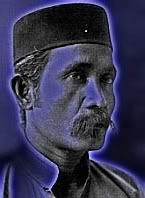18. How to...Wak Dök
There are two schools of thought about wak dök: one school says that it is a transitive act that requires an object, whilst another says that it is just an act of neglect that is akin to lök. They are both, of course, different from lök-lik, which is a cake.
Wak dök sometimes comes as a stoic act,
 as when a housewife carries on with her work even when she’s got a nagging ache. “Dök léh dok layang sangak,” she’ll tell her sympathising mates — one cannot pander to these aches and pains — “Kita paka wak dök je.” “I just pretend it isn’t there.” This act of wak dök is also called therapeutic neglect that sometimes works when the pain is an attention seeking one, but it can lead to dire consequences if its cause is deep-rooted. As happened to a man who walked ten days with an axe embedded in the back of his head thinking that he could just will the pain away by doing the wak dök. Wak dök is no cure for a splitting headache, especially if it involves a kapök kecik from our neighbouring Orang Barak.
as when a housewife carries on with her work even when she’s got a nagging ache. “Dök léh dok layang sangak,” she’ll tell her sympathising mates — one cannot pander to these aches and pains — “Kita paka wak dök je.” “I just pretend it isn’t there.” This act of wak dök is also called therapeutic neglect that sometimes works when the pain is an attention seeking one, but it can lead to dire consequences if its cause is deep-rooted. As happened to a man who walked ten days with an axe embedded in the back of his head thinking that he could just will the pain away by doing the wak dök. Wak dök is no cure for a splitting headache, especially if it involves a kapök kecik from our neighbouring Orang Barak.Sometimes your wak dök is referred to as wak dek with a variation in pronunciation that makes it an even more abstruse act. But there is no real mystery in the etymological origin of wak dök, though its cultural aetiology may require a whole day’s work. The phrase comes from the standardspeak Buat tidak, which is our wak dök compacted in our Trengganuspeak. But to unravel it in full to someone who isn’t used to the short cuts of a kampung walk you will have to explain that its real origin is actually buat tidak tahu that is oftentimes expressed as ‘make donno’ in Malaysian Englishspeak.
You can, as many people do, wak dök simply as a self-abnegating act, unbeknownst perhaps, by the world at large. The best form of wak dök however, comes with the flag to denote the outward nature of the act: as when someone is doing his darndest to annoy you with his attention-seeking acts such as tongue-pulling, or name-calling or doing things you’ve just told him a minute ago that he ought not. Sometimes a dandy comes your way in the hope of attracting your admiring attention — a stance known as wak èk — but you retaliate with your wak dök, which is a form of retaliatory neglect. For these, wak dök je is the state of being in wak dök.
This act of studious neglect is where wak dök comes closest to lök, which is letting things be in the hope that it will burn out, or just get tired and go to bed. “Lök kat dialah,” (“let him be”) is the final resort in dealing with the aberrant act of a child or the wayward ways of an overgrown idiot after fine words have failed or where harsh measures just don’t work. For the solitary wak dök, its next of kin is ök which is a multi-faceted word that carries here the meaning of just ‘bearing it’.
The opposite of wak dök is layang which also gives birth to the Trengganuspeak noun pelayang, that is, women in tight clothes that wait at tables and do many more things besides. There was a place for such activities in a cafe just outside the Panggong Sultana in days when Mak Ming was still keeper of its gate, but as we’re here for many things but that, we shall not now layang the thought.
There’s just one thing left to say about neglect and discomfort that was once expressed by Neil Diamond in his song about the tiger at the gate that made you unable to relax or relate. There seems to be two ways you can express that in Trengganuspeak: It’s either Rima dok ccököh kat pitu gate: dök léh nök layang, dök léh wak dök or Rima dök ccököh kat pitu gate: dök léh nök layang, dök léh nök lök. Discuss.


